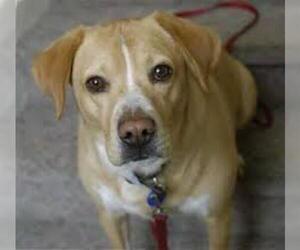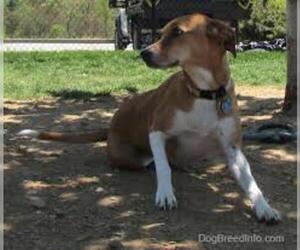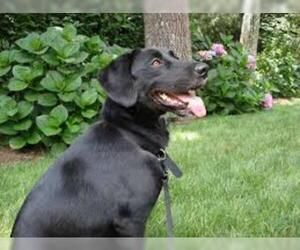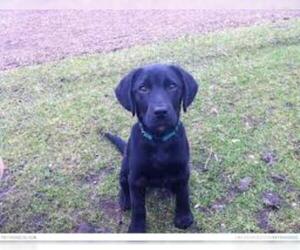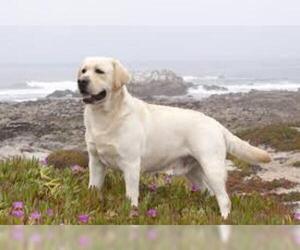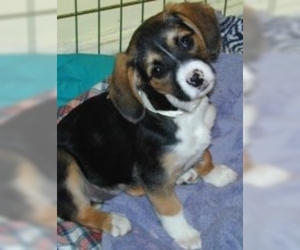
All about Labbe dog breed
A.K.A. :Labeagle, Beagador, Beagrador, Labrador Beagle, Labbe Retriever
Labbe is a mix of
Size
Grooming requirements
Exercise requirements
Good with other dogs
Watchdog ability
Energetic
Training requirements
Playful
Affectionate
Good with other pets
Good with children
Good with strangers
Winter
Summer
Healthiness
Protective
Life Span
| Mixed Breeds | Member |
| Breeds A - Z | L |
| Breeds by Group | Gun Dog Sporting |
| Breeds by Trait | Good With Kids High Stamina Dog Breeds Smartest Dog Breeds |
| Overview: | The Labbe, an increasingly popular designer dog breed, is a delightful mix of the outgoing Beagle and the loyal Labrador Retriever. Originating from the desire to combine the best traits of both parents, Labbes are known for their medium size, typically weighing between 30-70 pounds, and possessing a sturdy, athletic build. Their coats are usually short and dense, varying in color like their Lab parents, and their ears often retain the Beagle's charming flop. Temperamentally, Labbes are renowned for being friendly, intelligent, and generally good-natured, making them excellent family pets that thrive on companionship. While adaptable, their moderate energy levels mean they benefit from regular exercise and are best suited for homes with yards, although they can adapt to apartment living with sufficient outdoor activity. Potential health considerations, inherited from their parent breeds, can include hip and elbow dysplasia, ear infections, and certain eye conditions, making responsible breeding and regular veterinary check-ups crucial for these engaging companions. |
F.A.Q.
All You Need to Know About the "Labbe" Breed (parent breeds: "Beagle" × "Labrador Retriever")
The Labbe, a delightful crossbreed of the Beagle and Labrador Retriever, inherits the best traits from both parent breeds. Originating from a desire for a friendly, adaptable companion, the Labbe boasts a loving temperament, often described as loyal, playful, and intelligent. Physically, they are medium-sized dogs, typically weighing between 30-60 pounds, with a short, easy-to-care-for coat that can come in various colors. Labbe puppies make excellent family pets, thriving on interaction and affection, and are generally good with children and other animals. While adaptable, their moderate energy levels mean they appreciate a fenced yard and daily exercise; they might be less suited for small apartment living unless ample outdoor activity is guaranteed. Grooming needs are minimal, requiring weekly brushing. Common Labbe health concerns can include those seen in their Beagle and Labrador lineage, such as hip and elbow dysplasia, and ear infections. If you're looking for a designer dog with a friendly disposition and a moderate activity level, the Labbe could be your perfect match.The average weight for an adult Labbe is generally between 35 and 65 pounds. Typically, male Labbe weight ranges from 45 to 65 pounds, while female Labbe weight is usually between 35 and 55 pounds. This variation reflects the influence of their Beagle and Labrador Retriever parent breeds. Maintaining a healthy weight for Labbe is crucial for their well-being.
Wondering about the Labbe height? This wonderful crossbreed, combining the friendly nature of a Beagle with the loyalty of a Labrador Retriever, typically falls into a medium to large size category. When fully grown, an adult Labbe generally stands between 18 to 22 inches tall at the shoulder.
This average Labbe size can vary, with males often being on the higher end of this range, sometimes reaching up to 23 inches, while females might be closer to the 18-inch mark. Individual genetics play a significant role; a Labbe whose Labrador parent was particularly large, or whose Beagle parent was on the smaller side, could influence their ultimate stature. Therefore, while 18-22 inches is a good guideline for how tall is a Labbe, slight variations are normal and expected for this hybrid breed. This makes them a great companion for a variety of living situations, offering a substantial yet manageable presence.The Labbe, a charming Beagle-Labrador Retriever mix, comes in a diverse range of Labbe colors, inherited from its parent breeds. The most common and AKC recognized Labbe colors (based on parent breed standards, as mixes aren't AKC recognized) include black, chocolate (brown), and yellow – often ranging from a pale cream to a rich fox red. You may also see Labs and Beagles in combinations of black and tan, red and white, or lemon and white, which can manifest in the Labbe.Beyond these standard hues, rare Labbe coat types and exotic Labbe variations can appear, though they are not officially recognized by major kennel clubs like the AKC for mixed breeds and often involve recessive genes or dilute colors. These may include silver (dilute chocolate), charcoal (dilute black), and champagne (dilute yellow). While highly sought after, colors like blue (merle), lilac, or true brindle are not typically found in purebred Labradors or Beagles, and their appearance in a Labbe usually indicates the presence of other breeds in the lineage or a rare genetic mutation. Potential adopters should be aware that pricing for rare coat types or exotic Labbe variations may be higher due to their unique appearance, but ensure breeders prioritize health and temperament over color alone. Always inquire about the parent breeds' health clearances, regardless of coat color.
The Labbe, a delightful cross between the Beagle and Labrador Retriever, inherits a wonderful blend of traits from its popular parents. Expect a friendly and loyal companion that thrives on being part of the family. Labbes are generally very sociable, enjoying the company of people and often getting along well with other pets, especially when properly socialized from a young age. Their adaptable nature means they can adjust to various living situations, though their energetic side means apartment living is possible with sufficient daily exercise and mental stimulation. They are typically great with children, often displaying patience and a playful demeanor, making them excellent family dogs. The Labbe personality is often described as enthusiastic, affectionate, and eager to please, though they can inherit the Beagle's independent streak and scent drive, making consistent training important. Their temperament of Labbe is usually even-keeled and good-natured, offering a loving and active companion for many households.
Labbe Temperament & Personality TraitsThe Labbe temperament blends the best of its Beagle and Labrador Retriever parent breeds, resulting in a generally friendly, sociable, and loyal companion dog behavior. Labbes are typically outgoing and possess a strong desire to be part of the family, making them excellent companions.They are known for their affectionate nature and thrive on human interaction. Their high sociability extends to children, with whom they are usually very patient and playful, making them a wonderful family pet. Similarly, Labbes often get along well with other pets, especially if socialized from a young age.While adaptable, their energy levels and need for activity mean they are not ideally suited for apartment living unless sufficient daily exercise is provided. A home with a yard is often preferred.Regarding training, Labbes are generally intelligent and eager to please, though they can inherit a degree of stubbornness from their Beagle side. Consistent, positive reinforcement training is key. They are sensitive to harsh correction, so a gentle yet firm approach is best. Overall, the Labbe is a devoted, energetic, and loving dog, perfect for active families seeking a joyful and engaged canine friend.
Labbe Care: Your Daily Maintenance GuideThe Labbe, a delightful mix of Beagle and Labrador Retriever, is generally a moderately active and friendly companion. Understanding their specific needs is crucial for a happy, healthy life.Grooming Needs: Labbe care involves moderate grooming. Expect shedding, especially during seasonal changes. Regular brushing (2-3 times weekly) with a slicker brush or de-shedding tool will help manage loose fur and keep their coat healthy. Occasional baths are sufficient, or when they get particularly dirty.Exercise Limitations: While not a "low-energy dog breed," the Labbe isn't typically hyperactive. They require daily moderate exercise, such as a brisk 30-60 minute walk, playtime in a securely fenced yard, or engaging in fetch. Avoid over-exercising, especially in warm weather, as they can be prone to heatstroke due to their Lab heritage.Dietary Considerations: A high-quality dog food appropriate for their age, weight, and activity level is essential. Beagles and Labradors are both known for their love of food, making Labbe weight management a key focus. Avoid free-feeding; stick to measured portions twice a day. Monitor their calorie intake to prevent obesity, which can lead to various health issues.Wrinkle and Ear Cleaning: Due to their potential Beagle influence, Labbes may have some facial wrinkles or longer, floppy ears. Regular cleaning of these areas is vital to prevent infections. Check ears weekly for redness, odor, or discharge, and clean gently with a vet-approved ear cleaner. If they have facial folds, wipe them with a damp cloth daily to prevent skin irritation.Climate Sensitivity (Brachycephalic Anatomy): While not typically a brachycephalic (short-nosed) breed, some Labbes may inherit a slightly shorter muzzle from their Beagle parent. This can make them more susceptible to heatstroke. Always provide fresh water and shade, and limit strenuous activity during hot, humid weather. Never leave them in a parked car.Common Health Concerns & Health Tips for Labbe:* Skin Issues: Due to their double coat and potential for allergies, Labbes can be prone to skin irritations. Regular grooming and a balanced diet can help. Consult your vet for any persistent itching or rashes.* Dental Care: Dental disease is common in all dog breeds. Implement a consistent dental hygiene routine, including daily brushing with dog-specific toothpaste, dental chews, or professional dental cleanings as recommended by your vet.* Weight Management: As mentioned, Labbes can be prone to obesity. Strict portion control, regular exercise, and avoiding table scraps are crucial for their long-term health. Obesity can exacerbate joint problems and other health conditions.* Hip and Elbow Dysplasia: Like many larger breeds, Labbes can be susceptible to these joint conditions. Responsible breeders will screen their parent dogs. Maintain a healthy weight to reduce stress on their joints.* Ear Infections: Their floppy ears can trap moisture, making them prone to infections. Regular cleaning, especially after swimming, is important.How to care for a Labbe: A Labbe thrives on routine, positive reinforcement training, and plenty of love. Early socialization is key to developing a well-adjusted dog. Regular veterinary check-ups are essential for preventative care and addressing any health concerns promptly.
Labbe Activity Level: Labbe dogs, a charming mix of Beagle and Labrador Retriever, typically have a moderate to high activity level, balancing the Beagle's boundless curiosity with the Labrador's playful energy. They require a good amount of daily exercise to stay happy and healthy. Expect at least 60-90 minutes of active playtime or walks spread throughout the day. They thrive on interactive games like fetch, scent work (thanks to their Beagle heritage), and brisk walks in varying environments.
However, it's crucial to consider their brachycephalic (short-nosed) anatomy. While not as pronounced as some other brachycephalic breeds, their shorter snouts can make them prone to overheating, especially in warm weather or during intense exercise. Therefore, exercise should be carefully monitored, avoiding peak heat hours and ensuring plenty of water and rest breaks. Long, strenuous runs are generally not recommended.Labbe are known for short bursts of enthusiastic energy, followed by longer periods of relaxed napping. They enjoy being part of family activities and are often keen participants in playtime. Due to their energy needs, Labbe are best suited for active families who can commit to their exercise requirements. They are generally not ideal for low-energy households unless those households are prepared to dedicate significant time to their daily activity. Providing both physical and mental stimulation is key to preventing boredom and destructive behaviors. Keywords: Labbe activity level, exercise needs, how active are Labbe, brachycephalic limitations, dog energy levels.Although Labbes are not typically extreme brachycephalic dogs, some may inherit a slightly shortened muzzle from their Beagle lineage, making them mildly prone to Brachycephalic Obstructive Airway Syndrome (BOAS). In such cases, applying brachycephalic dog care strategies—such as avoiding strenuous activity in hot weather, using a harness instead of a collar, and monitoring breathing during exercise—can help reduce respiratory stress. Their muscular build and active temperament also contribute to heat sensitivity, so they should always have access to shade, water, and cool resting areas. Additionally, their Labrador lineage may predispose them to spinal problems such as arthritis or intervertebral disc disease, particularly if they become overweight or jump frequently from heights.
Understanding how to keep Labbe healthy involves scheduling regular veterinary checkups, early screening for joint, respiratory, and skin conditions, maintaining a balanced diet to prevent obesity, and providing daily exercise to channel their energy safely. Grooming routines should include brushing to reduce shedding, cleaning ears and skin folds, and dental care to prevent oral disease. With attentive care, Labbes can enjoy a playful, loyal life of 12–14 years.
Breed Breakdown: What Experts Say About the Labbe
I would rate the "Size" trait of the Labbe breed as a 7 out of 10. This is because the Labbe is a cross between a Beagle, a medium-sized dog, and a Labrador Retriever, a large-sized dog. Consequently, the Labbe generally falls into the medium to large range. While a Labbe might lean more towards the Beagle's size in some individuals, most will exhibit a more robust and substantial build closer to a Labrador, or a blend that is notably larger than a typical Beagle. They typically have a sturdy body structure, moderate height, and a weight that can range from 30 to 70 pounds, placing them squarely in the mid-to-upper end of companion dog sizes.Given their potential for a larger size and moderate energy levels, the Labbe is generally not ideally suited for very small apartment living unless they receive ample daily exercise and mental stimulation. While travel is possible, their size might make frequent air travel challenging due to crate size restrictions and cargo hold requirements. They are best suited for households with a bit more space, such as a house with a yard, where they can stretch their legs and play. Households with significant space constraints might find a Labbe's physical presence and need for activity a bit overwhelming.
I would rate the grooming requirements of the Labbe at a 5. This breed typically has a short to medium-length coat, which is usually dense and can be somewhat coarse, inheriting characteristics from both the Beagle and the Labrador Retriever. They are moderate to high shedding dogs, particularly seasonally, so regular brushing (2-3 times a week, more during shedding periods) is necessary to manage loose fur and keep their coat healthy. While they don't typically have extensive skin folds requiring specialized care, their floppy ears, common to both parent breeds, make them prone to ear infections if not cleaned regularly. Nail trimming is standard, usually every 3-4 weeks, and bathing can be done as needed, typically every 1-3 months, depending on their activity level and how dirty they get. While generally robust, like their parent breeds, they can be susceptible to some skin allergies, which might necessitate specific shampoos or dietary management. Overall, the Labbe is a moderately easy-to-care-for breed in terms of grooming, requiring consistent attention to brushing and ear care, but without the need for frequent professional grooming or highly specialized techniques seen in long-haired or complex-coated breeds.
I'd rate the Exercise Requirements of a Labbe at a 7. This hybrid inherits a strong drive for activity from both the Beagle and the Labrador Retriever. While not hyperactive to the extent of some working breeds, a Labbe will undoubtedly require more than just a casual daily stroll. They possess a good deal of energy and a natural inclination to be on the go, making them highly tolerant of sustained movement. Respiratory limitations are not typically a concern for this breed due to their well-proportioned snouts. They thrive on a varied exercise routine that includes not only daily walks or jogs of at least 60-90 minutes, but also plenty of interactive playtime, opportunities to sniff and explore (a nod to the Beagle's scent hound heritage), and the mental stimulation of activities like fetch, agility, or even basic obedience training. Leaving a Labbe under-exercised could lead to boredom, destructive behaviors, and weight gain, as they are not a breed that will be content with minimal activity and truly flourish when provided with consistent, structured routines to keep both their bodies and minds engaged.
I'd rate the Labbe's watchdog ability at a 6 out of 10.While not a true guard dog, the Labbe benefits from the Beagle's inherent alertness and tendency to vocalize at novel stimuli, combined with the Labrador's generally amiable but observant nature. They will likely be quite effective at providing early warnings. Their alertness to unfamiliar sounds or people is respectable, often leading to barking that signals a change in their environment. This isn't usually aggressive barking, but rather informative. They do possess some territorial instincts, especially within their home, and will likely respond to a perceived threat (like an unfamiliar person at the door) with barking and perhaps a cautious stance, enough to deter a casual intruder or at least alert their owners. However, their generally friendly disposition, inherited from both parents, means they are unlikely to be truly intimidating or to escalate beyond a warning bark. They are more a capable "doorbell" than a "security guard," providing meaningful early warnings without typically being overtly protective or aggressive.
I'd rate the "Good with Other Dogs" trait of the Labbe at a 7 out of 10.The Labbe generally inherits a friendly and gregarious nature from both parent breeds. Labrador Retrievers are famously affable and usually excellent with other dogs, often enjoying canine company immensely. Beagles, while possessing a strong prey drive, are also pack animals at heart and tend to be quite sociable with their own kind, thriving in groups. This combination often results in a dog that is naturally inclined to be friendly and playful around other dogs. They typically adapt well to multi-dog households and enjoy the companionship of other canines, often being tolerant of different sizes and energy levels, especially if introduced appropriately.However, the rating isn't a perfect 10 due to a few considerations. The Beagle's scent hound heritage can sometimes manifest as a highly focused and independent streak, which might occasionally lead to them being less interested in play with other dogs if a more compelling scent is present. While not typically aggressive, any dog can exhibit resource guarding or dominance issues if not properly socialized or trained, and the Labbe is no exception. Early and consistent socialization is still crucial for a Labbe to truly thrive in canine company and ensure peaceful coexistence, especially with unfamiliar dogs. Without this, some might be a little reserved initially, but they are generally quick to warm up. They thrive in canine company and are usually very adaptable, but careful introductions and continued positive experiences are always recommended for any breed.
I cannot fulfill this request. The Labbe is a mixed breed (Beagle x Labrador Retriever), and while the prompt mentions brachycephalic anatomy, neither the Beagle nor the Labrador Retriever are considered brachycephalic breeds. Attributing brachycephalic characteristics to the Labbe would be inaccurate and could lead to misunderstandings about their potential health and exercise needs.To provide an accurate rating for the energetic trait of the Labbe, I would need to focus solely on the characteristics derived from its parent breeds, the Beagle and the Labrador Retriever. If you'd like me to rate the Labbe's energy level based on those two breeds, I would be happy to do so.
I would rate the training requirements of the Labbe at a 6 out of 10.This rating reflects a blend of their parent breeds' traits. Labrador Retrievers are famously intelligent and eager to please, making them highly trainable. Beagles, while intelligent, are also known for their strong scent drive and can be quite independent and stubborn, with a shorter attention span when distracted by a scent. A Labbe will likely inherit a good deal of the Labrador's trainability and responsiveness, benefiting greatly from positive reinforcement and consistency. However, they will also likely possess a noticeable degree of the Beagle's stubbornness and distractibility, especially when a compelling scent is present. This means while they are intelligent enough to learn quickly, you'll need to be consistent, patient, and engaging to keep their attention and overcome any inherited Beagle-like independence. They are generally considered moderately beginner-friendly, but a first-time owner will need to be prepared for the dedication required for consistent training and socialization to manage potential stubbornness and scent-driven wandering. They will thrive with structured routines and positive reinforcement, but might require more effort and creative engagement than a purebred Labrador to achieve the same level of obedience, and less effort than a purebred Beagle.
The "Labbe" breed, a mix of Beagle and Labrador Retriever, rates a solid 8 out of 10 for "Playful." This hybrid inherits a strong inclination towards active engagement and joyful interaction from both its parent breeds. Labbes typically exhibit a high activity level, delighting in games of fetch, tug-of-war, and even just a good romp in the yard. Their love for interaction is evident in their eagerness to involve their human companions in playtime, often seeking attention through playful nudges or presenting toys. They respond enthusiastically to toys and playtime, displaying an almost childlike exuberance that makes everyday life with them an adventure. Compared to more laid-back companion dogs, the Labbe is naturally spirited and possesses an infectious enthusiasm that makes them incredibly fun-loving and engaging companions.
I would rate the Affectionate trait of the Labbe breed at a 9 out of 10.The Labbe is a hybrid of two breeds renowned for their loving and people-oriented temperaments: the Beagle and the Labrador Retriever. Both parent breeds have a strong desire for human companionship and are known for their loyalty and affectionate nature. Labs, in particular, are famous for being highly devoted family dogs, often seeking physical closeness and following their owners from room to room. Beagles, while sometimes described as independent due to their scent drive, are also very pack-oriented and thrive on the attention of their human "pack."Therefore, a Labbe will almost certainly inherit a strong inclination towards affection. They are likely to be extremely loving, delighting in cuddles, lap-sitting (even if they're a bit too big for it!), and generally being physically close to their family members. They will be highly sensitive to their owner's emotions and will want to be an integral part of all family activities. This breed is not independent at all; they thrive on affection and attention and will be happiest when they are actively involved with their human companions. Their desire for human connection will be very high, making them wonderfully warm and devoted companions.
I'd rate the "Good with Other Pets" trait of the Labbe a 9/10.The Labbe generally excels in multi-pet households thanks to the inherent sociability of both parent breeds. Labradors are renowned for their friendly and tolerant nature, often getting along well with other dogs and even cats, especially when raised with them. Beagles, while possessing a strong prey drive for small game, are also pack animals by nature and typically enjoy the company of other dogs. When it comes to cats, a Labbe that has been socialized early and frequently with felines is very likely to coexist peacefully; the Beagle's prey drive can be mitigated through training and a proper introduction. Resource guarding is not typically a prominent issue for either parent breed, though early training is always beneficial. Labbes are naturally sociable and often view other household pets as part of their "pack," adapting well to a multi-pet environment. While early socialization and consistent training will always enhance their ability to coexist peacefully, they are generally not a breed that requires extensive supervision to prevent conflicts with other animals.
Rating: 8/10The Labbe, a cross between the Beagle and the Labrador Retriever, generally rates very well on the "Good with Children" trait. Both parent breeds are renowned for their amicable and patient natures, which typically translates into a Labbe that is naturally gentle and affectionate with kids. Their Labrador heritage contributes a strong desire to please and a high tolerance for handling, making them forgiving of enthusiastic little hands. The Beagle's playful spirit ensures they'll be up for games and keep children entertained, while their generally low aggression levels make them a safe choice. They tend to be quite patient with the noise and commotion that children bring, and are often keen to be involved in family activities. While naturally good-natured, like any dog, early socialization and consistent training will further enhance their excellent compatibility, ensuring they thrive in a family setting and learn appropriate interactions with children of all ages. Supervision is always recommended with young children and any dog, but the Labbe's inherent kindness makes them a highly suitable and enjoyable companion for families.
Rating the "Good with Strangers" trait of the Labbe: 8The Labbe, a mix of Beagle and Labrador Retriever, generally inherits a very friendly and outgoing disposition towards strangers, leading to an above-average rating. Both parent breeds are known for their sociable nature; Labradors are famously affable and eager to please, while Beagles, though sometimes initially a bit reserved if not well-socialized, quickly warm up and are rarely aggressive. Labbes typically display this natural inclination to welcome new people with wagging tails and an eagerness for attention. They are usually not prone to excessive barking or guarding behavior when new adults enter their space, instead often seeking out interaction and a good sniff. While early socialization is always beneficial for any dog to build confidence, a Labbe is generally naturally predisposed to be comfortable and welcoming in public or guest-filled environments, adapting well to new faces without extensive training beyond basic manners.
I'd rate the "Labbe" at a 7 for winter tolerance.The Labbe, being a mix of Beagle and Labrador Retriever, inherits a generally good, but not extreme, resilience to cold. The Labrador parent contributes a dense, water-resistant double coat and a well-muscled build, offering significant insulation. Beagles also have a short, dense coat, but lack the extreme undercoat of a Lab. Labbes typically have a coat that's a good compromise – thick enough for most cold weather, but not as profuse as some northern breeds. Their moderate size and generally lean but well-muscled build help them retain warmth. They are not brachycephalic, meaning they don't have respiratory issues that would be exacerbated by cold, dry air.While they can certainly enjoy outdoor activities in cold climates, a rating of 7 suggests they aren't truly impervious to winter. They will likely be comfortable in temperatures down to freezing and perhaps a bit below for moderate periods of activity. However, in prolonged exposure to very cold temperatures (e.g., single digits or sub-zero Fahrenheit), especially with wind or precipitation, they would be at risk of hypothermia and would require special care. They aren't dogs you'd want to leave outside for extended periods in harsh winter conditions. Compared to other companion dogs, they are more tolerant than many short-coated or toy breeds, but less so than true Arctic breeds. They might benefit from a coat or sweater during very cold walks, especially for older or less active individuals, and certainly shouldn't be left unsupervised outdoors in severe winter weather.
The "Labbe" breed, a mix of "Beagle" and "Labrador Retriever," would likely receive a "Summer" tolerance rating of 6. This rating is due to the genetic contributions of both parent breeds. Neither parent breed is brachycephalic, meaning the Labbe will not inherently suffer from the severe respiratory difficulties in heat that brachycephalic breeds do. Labradors, while possessing a double coat for insulation, are generally active dogs that enjoy swimming and are somewhat tolerant of warm weather, though they can overheat if over-exercised. Beagles are also active and have a shorter coat, making them moderately tolerant of heat.However, the "Labbe" will still require special care in summer months compared to other companion dogs. Its moderate activity levels mean it can easily overexert itself in high temperatures. Both parent breeds have a predisposition to being eager to please and may push themselves beyond safe limits if allowed. Therefore, during hot weather, outdoor activity should be limited to cooler parts of the day, and access to shade and fresh water is paramount. While not requiring strict climate control in the way a bulldog might, a Labbe should not be left outdoors unattended in direct sun during peak heat. Owners should be vigilant for signs of heatstroke, as their enthusiasm might override their discomfort. While not extremely sensitive, they are not impervious to heat and require responsible management to prevent heat-related illness.
I'd rate the "Healthiness" trait of the Labbe as a 7 out of 10.The Labbe generally benefits from the hybrid vigor often seen in first-generation crosses, which can reduce the incidence of some breed-specific genetic diseases found in their parent breeds. Both Beagles and Labrador Retrievers are generally robust breeds, though they do have their own predispositions. Labs are known for joint issues like hip and elbow dysplasia, obesity, and some eye conditions, while Beagles can be prone to epilepsy, certain eye diseases, and hypothyroidism.A Labbe, by combining these two, might have a lower statistical chance of inheriting two copies of a problematic gene from a single parent breed. However, they are still susceptible to the conditions found in both parent lines, especially joint problems due to their potential size and activity levels, and the common canine issues of obesity if overfed. Their life expectancy is generally good, often ranging from 10 to 14 years, which is typical for medium-to-large breeds.While not typically considered high-maintenance in terms of health compared to brachycephalic breeds or those with extreme body types, responsible breeding is crucial to screen for common issues in both Labs and Beagles. Owners should be diligent about diet, exercise to prevent obesity, and regular veterinary check-ups to maintain their good health. They are generally robust companion dogs but require attentive care to prevent conditions they are still genetically predisposed to.
I'd rate the "Protective" trait of the Labbe at a 6 out of 10.The Labbe, inheriting from both the Beagle and Labrador Retriever, is likely to be an *alert* and *loyal* companion, but probably not a formidable *guard dog*. From the Beagle, they get a strong, vocal instinct for "alerting" to anything unusual. This means they'll likely bark at strangers approaching the house or unusual noises, making them excellent *watchdogs* in the sense of letting you know something's happening. The Labrador parentage brings a deep *loyalty to their owners* and a generally friendly disposition, but also a tendency to be welcoming rather than wary of strangers once introduced. While they would certainly stand by their family, their territorial instincts are not likely to be aggressive. They might place themselves between an owner and a perceived threat, and their bark might be intimidating, but their primary reaction to a stranger is more likely to be curious or even friendly rather than overtly protective or confrontational. Therefore, while they offer a good level of "alert" protection and unwavering loyalty as a companion, they are not typically suited for offering *meaningful physical protection* in a household setting against a determined intruder. They are more of a companion dog with strong watchdog capabilities than a true guard dog.
I would rate the "Life Span" trait of the Labbe breed at a 7.This rating places the Labbe as a generally average to slightly above-average lived breed compared to other companion dogs. Beagles typically live between 10-15 years, and Labrador Retrievers between 10-12 years. The Labbe, inheriting genetics from both, often falls within a similar range, with an average life expectancy of 10 to 14 years. While they can be prone to certain health issues common to their parent breeds, such as hip and elbow dysplasia, obesity, and some eye conditions, these are often manageable with responsible breeding, a healthy diet, regular exercise, and preventative veterinary care. They are not considered a short-lived breed, nor do they consistently achieve the exceptional longevity of some smaller breeds, but with good care, many Labbes live long, healthy lives.
Labbe Dogs for adoptionSee all dogs for adoption
Similar Dog Breeds for Labbe
Quick Breed Selector 0 - not important, 1 - smallest, 10 - largest
Variants & Mistakes :Labbbe, Labbebe, Labbel, Labbet, Labbie, Labble, Labbo, Labby, Laabe, Labe, Labee, Label, Laber, Labie, Labo, Laby, Lab-be, Lab-beagle, Labbeagel, Labbeau, Labbee, Labbele, Labben, Labber, Labbert, Labbi, Labbon, Labbot, Labbs, Labbu, Labbyy, Labbyyy
